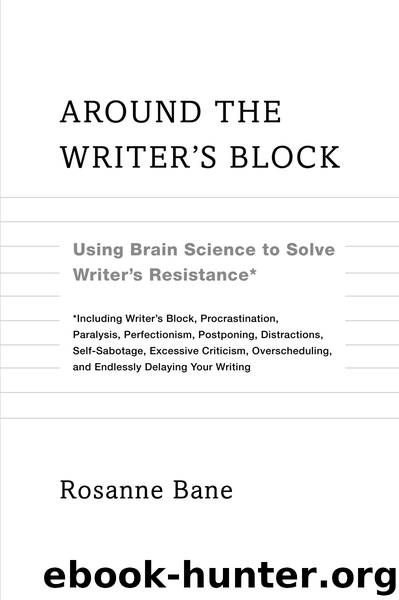Around the Writer's Block by Rosanne Bane

Author:Rosanne Bane
Language: eng
Format: epub
Publisher: Penguin Publishing Group
Published: 2016-04-20T16:23:27+00:00
What Rewards Do to Creativity
Rewards narrow both the depth and breadth of our thinking to, “What do I have to do to get the reward?” which precludes the kind of creative thinking that comes from open-ended questions like, “How about . . .” “Why not . . .” and “What else . . .”
Rewards also reduce or destroy intrinsic motivation, which is essential for creativity. After reviewing three decades of research studies, Edward Deci concluded, “Careful consideration of reward effects reported in 128 experiments lead to the conclusion that tangible rewards tend to have a substantially negative effect on intrinsic motivation.”9
Or as Mark Twain put it, “Work consists of whatever a body is obliged to do, and . . . Play consists of whatever a body is not obliged to do.”
Rewards send the message, “I know this isn’t something you’re going to like to do, so I promise to give you something you will like if you do this task.” You might think that when we’re promised a reward for something we want to do anyway, we’d be smart enough to just take the reward and think, “Ha, got you fooled. I enjoyed the task and got the reward.” And in some situations we can do that, but the presence of a reward frequently changes our perception of the task from play to work, just as Mr. Twain predicts.
But it’s important to note that rewards have this negative effect on intrinsic motivation only when they are contingent, that is, when they are some form of, “If you do this, then you get that.” Unexpected rewards that are a celebration after the fact, the “Now that you’ve made this effort, here’s a reward” variety, actually boost future creativity.
Contingent, if-then rewards limit autonomy, one of the three key sources of intrinsic motivation. In one study, Teresa Amabile, one of the world’s leading researchers on creativity, asked twenty-three professional artists to submit ten commissioned works and ten noncommissioned works, selected by the artists at random. Not surprisingly, the artists reported that they had felt more constrained when working on the commissioned pieces. Furthermore, a panel of artists and curators, who were unaware of the purposes of the study, consistently found the commissioned works less creative than the noncommissioned works.10
But Amabile’s study also discovered that when artists saw the commission as enabling them to do something interesting and exciting, or when they thought the commission provided useful information or feedback, artists produced works that the panel of judges considered as creative as the noncommissioned work.
As long as creative people can keep their focus on the creative task instead of the reward, the reward doesn’t have to impair their performance. In The Owner’s Manual for the Brain, Dr. Pierce J. Howard observes, “The highest creativity occurs when we discover the need for a creative response ourselves and choose to contribute independent of any possible external constraints. When external constraints, such as deadlines, rewards or punishers, are imposed on a personally desirable task, creativity can still flourish if we are able to cognitively minimize the constraints.
Download
This site does not store any files on its server. We only index and link to content provided by other sites. Please contact the content providers to delete copyright contents if any and email us, we'll remove relevant links or contents immediately.
Asking the Right Questions: A Guide to Critical Thinking by M. Neil Browne & Stuart M. Keeley(5708)
Autoboyography by Christina Lauren(5204)
Eat That Frog! by Brian Tracy(4483)
Dialogue by Robert McKee(4353)
Sticky Fingers by Joe Hagan(4144)
Journeys Out of the Body by Robert Monroe(3590)
Annapurna by Maurice Herzog(3448)
Full Circle by Michael Palin(3415)
Schaum's Quick Guide to Writing Great Short Stories by Margaret Lucke(3345)
Elements of Style 2017 by Richard De A'Morelli(3324)
The Art of Dramatic Writing: Its Basis in the Creative Interpretation of Human Motives by Egri Lajos(3037)
Atlas Obscura by Joshua Foer(2932)
Why I Write by George Orwell(2913)
The Diviners by Libba Bray(2909)
In Patagonia by Bruce Chatwin(2896)
The Fight by Norman Mailer(2887)
The Mental Game of Writing: How to Overcome Obstacles, Stay Creative and Productive, and Free Your Mind for Success by James Scott Bell(2876)
Venice by Jan Morris(2546)
The Elements of Style by William Strunk and E. B. White(2454)
